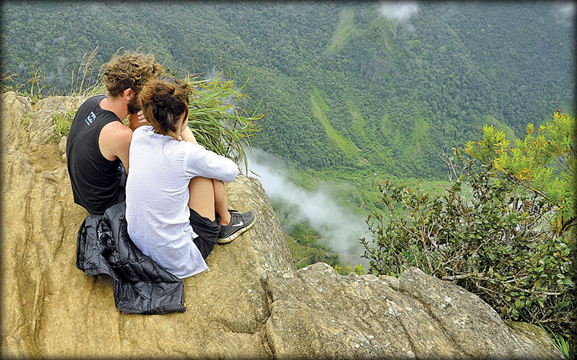|

Precariously enticing
Treasured by the locals
as well as foreigners,World's End covers an area of 32 hectares at a
height of 7200 feet from mean sea level. It was declared a natural
reserve in 1969 and a national wild sanctuary in 1988.
An awe inspiring 7200 feet above sea level, the World’s End is
something the adventurer in one wants to strike off before taking on
bigger, more challenging tasks, like perhaps abseiling from the Knuckles
range. But when the adrenaline rush is spiked with what could have
easily turned out to be a great tragedy, one automatically pauses to
ponder, not just the challenge of the trek and the pristine vistas at
journey’s end, but also the macabre attraction that has many lovers
choosing it as a grand gesture of defiance and eternal love. s
 What
is it about World’s End that star crossed lovers choose it as their end
point? Moot question, for in this instance, it wasn’t so much the ending
of lives but accidental free falls, saving graces and daring rescues
that held one’s attention. Hours before, on this eventful day, a young
Dutch couple on their honeymoon, had been enjoying the scenic wonders
that World’s End dishes out without fail. Eager to capture these moments
for posterity, the young husband had for a moment forgotten where he
was, overstepped and had literally taken a flyer off the cliff. What
is it about World’s End that star crossed lovers choose it as their end
point? Moot question, for in this instance, it wasn’t so much the ending
of lives but accidental free falls, saving graces and daring rescues
that held one’s attention. Hours before, on this eventful day, a young
Dutch couple on their honeymoon, had been enjoying the scenic wonders
that World’s End dishes out without fail. Eager to capture these moments
for posterity, the young husband had for a moment forgotten where he
was, overstepped and had literally taken a flyer off the cliff.
With solid ground thousands of feet away, death was a certainty, but
for the fortuitous angling of a tree branch, which snagged the flying
Dutchman and held him in woody safety. Nobody volunteered to take the
risk of rescuing him from the precarious position. And even if they
wanted to there was no guarantee of a safe rescue. Precious minutes were
spent pondering tragic what ifs, while the Sri Lanka Army Commandos
stationed in Nuwara Eliya were contacted and given the tough job of
rescuing the Dutchman from what was literally the jaws of death.
The death-defying commandos, skilled in operating uphill and down
dale were up for the task. Within minutes they reached the helpless
young Dutchman and enacted what will go down in history as one of the
greatest rescue jobs.
Following the near tragedy, many civic-minded people reiterated the
dire need for protective measures to ensure the safety of visitors.
However, environmentalists and nature-lovers are not in favour of such
measures, deeming them an obstruction to the beauty of World's End.
However, they believe the ever present danger the world’s end poses to
the over eager visitor could be minimised by conducting awareness
programmes.
Text and Pix by Susantha Wijegunasekara
Tragedies recalled
|
Apasali the
area postman:
I have
brought down 12 - 14 bodies. When they are found, the bodies
have disfigured faces and broken limbs due to the impact of
the fall. We have to walk three and half kilometres to the
forest. The police have to inform the forest department and
when the police come here, the search operation begins. We
are not allowed to go without their permission.
|
|
Priyankara
Kularatne, Estate Superintendent, Balangoda Plantations:
The
recent incident of the foreigner who survived the fall is my
first experience of a World’s End tragedy. I came to know of
this accidental fall through a news alert. I went there from
the Negrak Bungalow. There is always the risk of an
accidental fall as there is no protective fence and its life
threatening. Four months of the year the World's End
experience strong winds, this is very dangerous.
During
the rainy season, the place can be slippery. The concrete
beams near the viewing point too can pose a threat. There
were many tragic incidents before and it is a miracle that
this Dutchman had a happy ending.
A
safety fence a few feet away from the edge is something that
the authorities must give thought to now. before the place
claim another life. Not many will think of climbing over the
fence and risking their life to get a picture.
Everyone falling off World's End drop on Negrak, to the
Upper division. There are people in the line houses there,
who make a living out of searching and retrieving those
bodies. Going by the location the person dropped off, these
men can tell where the body is. |
|
Sunanda Raja, another
resident:
When a
man falls off World's End, we get a message from Pambahinna
Police station. We gather up a search team and go. There is
only a narrow footpath leading to the place.
We get
’santhosam’ money when the body is brought back.
|
|
Periyasami Subramanium a
resident of the area:
I
remember a couple from Colombo jumped off the cliff. There
was also a Buddhist priest from Matara who jumped off.
Similar to what happened with the Dutchman, sometime ago, an
Australian also fell of the end, while posing with his wife.
When
people fall off from World's End, we go in search of the
bodies. The search team consists of two police officers, and
a group of youth from our village. If it is a foreigner we
usually have two officers from the concerned embassy or high
commission.
Once
we went in search of a foreigner who weighed about 140kgs.
We searched and searched but the body could not be found for
a long time. Then we saw a tree with a broken branch. Under
that tree we saw the man lying dead.
Earlier, the men from the village volunteered in the search
operations, but now assisting in search operations have
become an income generator. if I remember correct, at first
they charged Rs.1500. But for that Australian man they asked
for Rs.115, 000. I believe they also received some 8-9
bottles of arrack.
There
is also the incident where a 70-year- old woman, a
grandmother, from Kurunegala jumped off. She had been in an
elder’s home although she had three children, all of whom
were public servants. These were details we saw in the
papers.
She
had arrived at Nuwara Eliya and taken a three-wheeler to
Horton's plains. We heard she had stared at the scenery
beyond World's End for sometime before making a dash over
the cliff.
The
children came in search of the body and they had to pay
something like Rs. 60, 000 for the youth who joined in the
search party.
It's
not an easy task to bring down these bodies from the base of
the world's end. The route to that area is through a steep
winding path in the thick jungle. The place is very cold and
dark. We wrap what is left of the bodies in cellophane so
that it will withstand the rough ride downhill.
In
certain steep places we use a rope to take it down and in
certain tricky slopes we roll it down. There is no way it
can be lifted and carried in those places. Once we pass the
difficult area only, we lift it up and carry with due
respect. |
|

Baker’s Bend A foreigner named Baker fell off his
horse carriage while coming down the mountain near this
place. It is said he lost control because of the speed. That
is why it's called Baker's Bend. It is 5000 feet above sea
level. |
|

